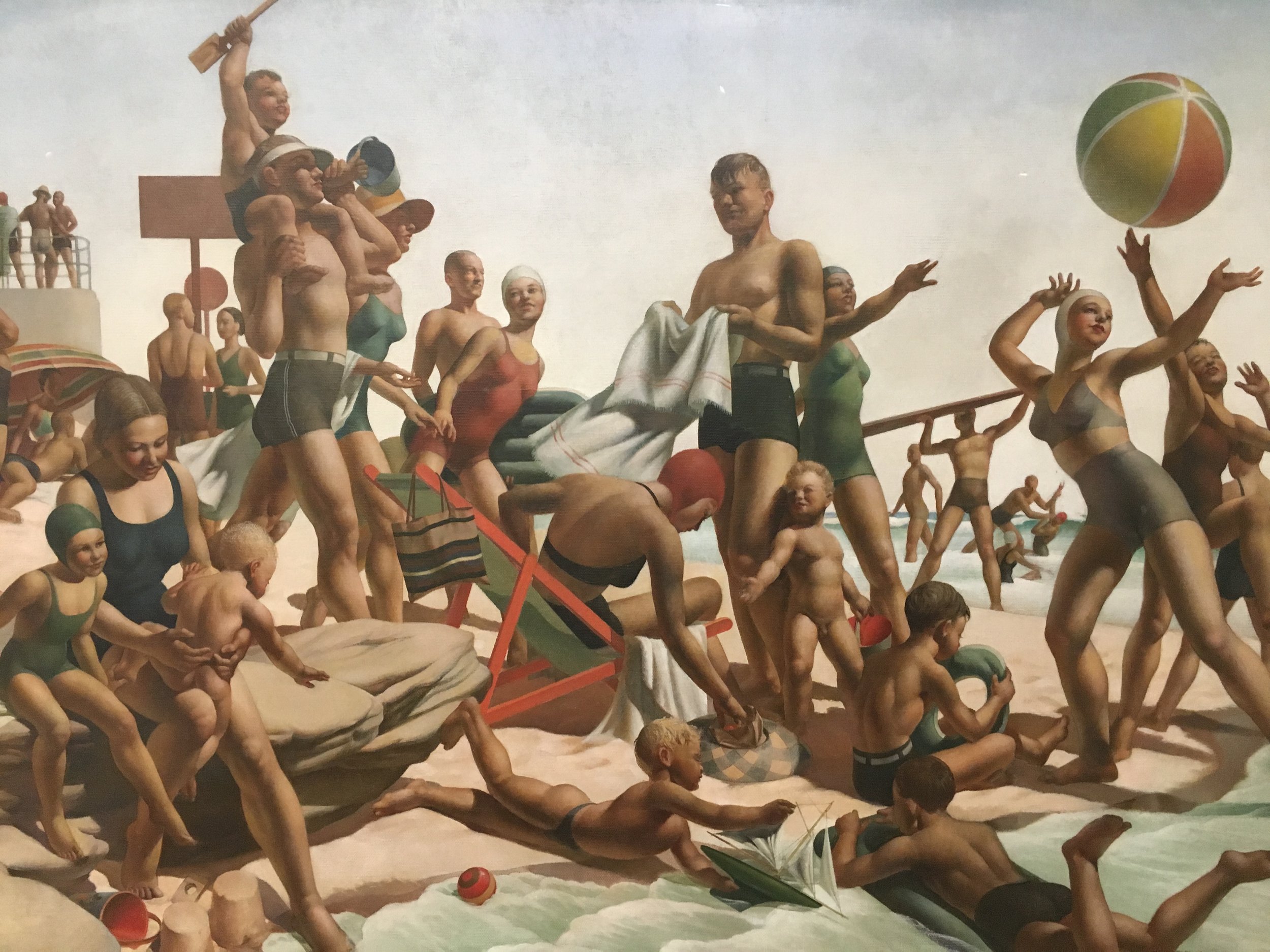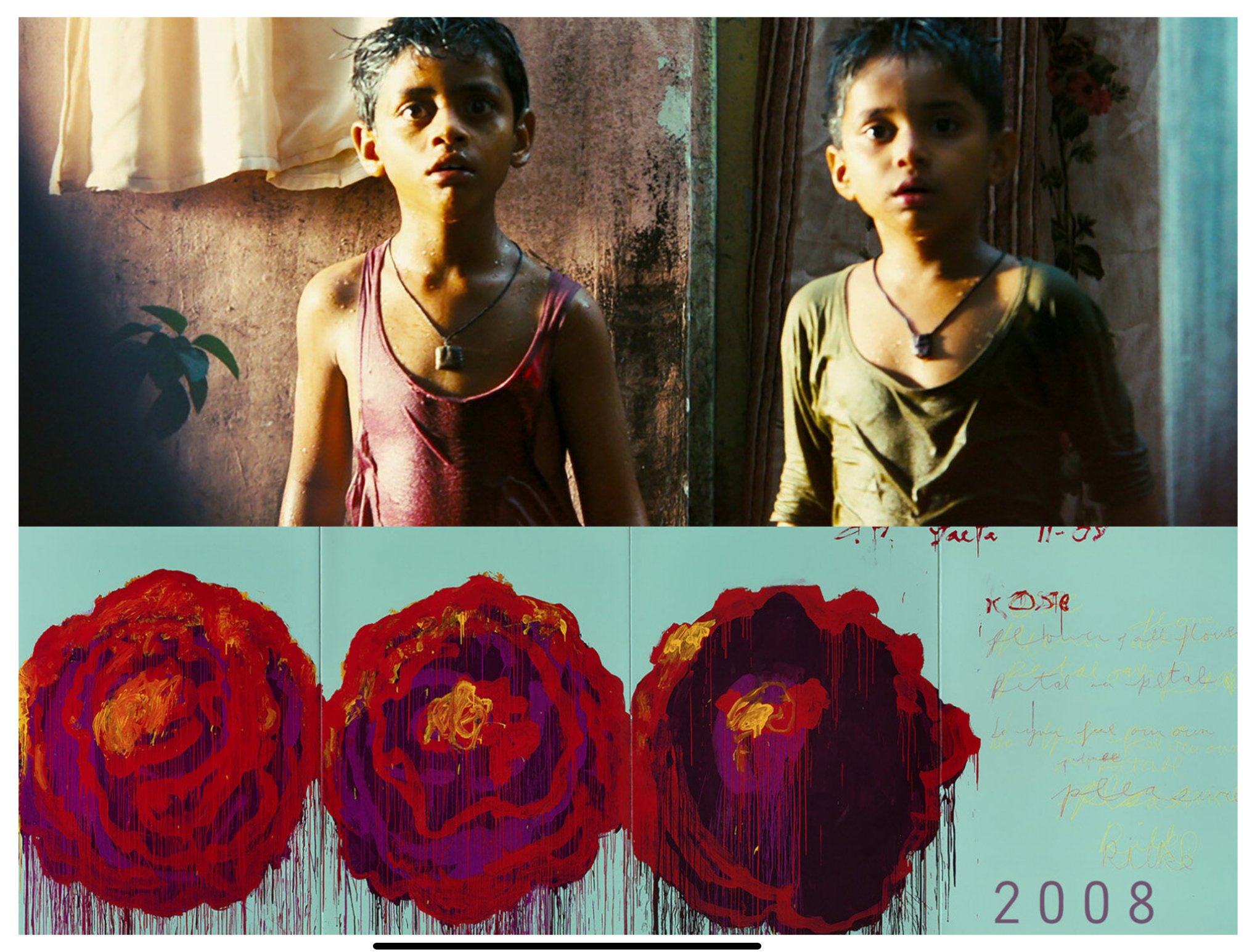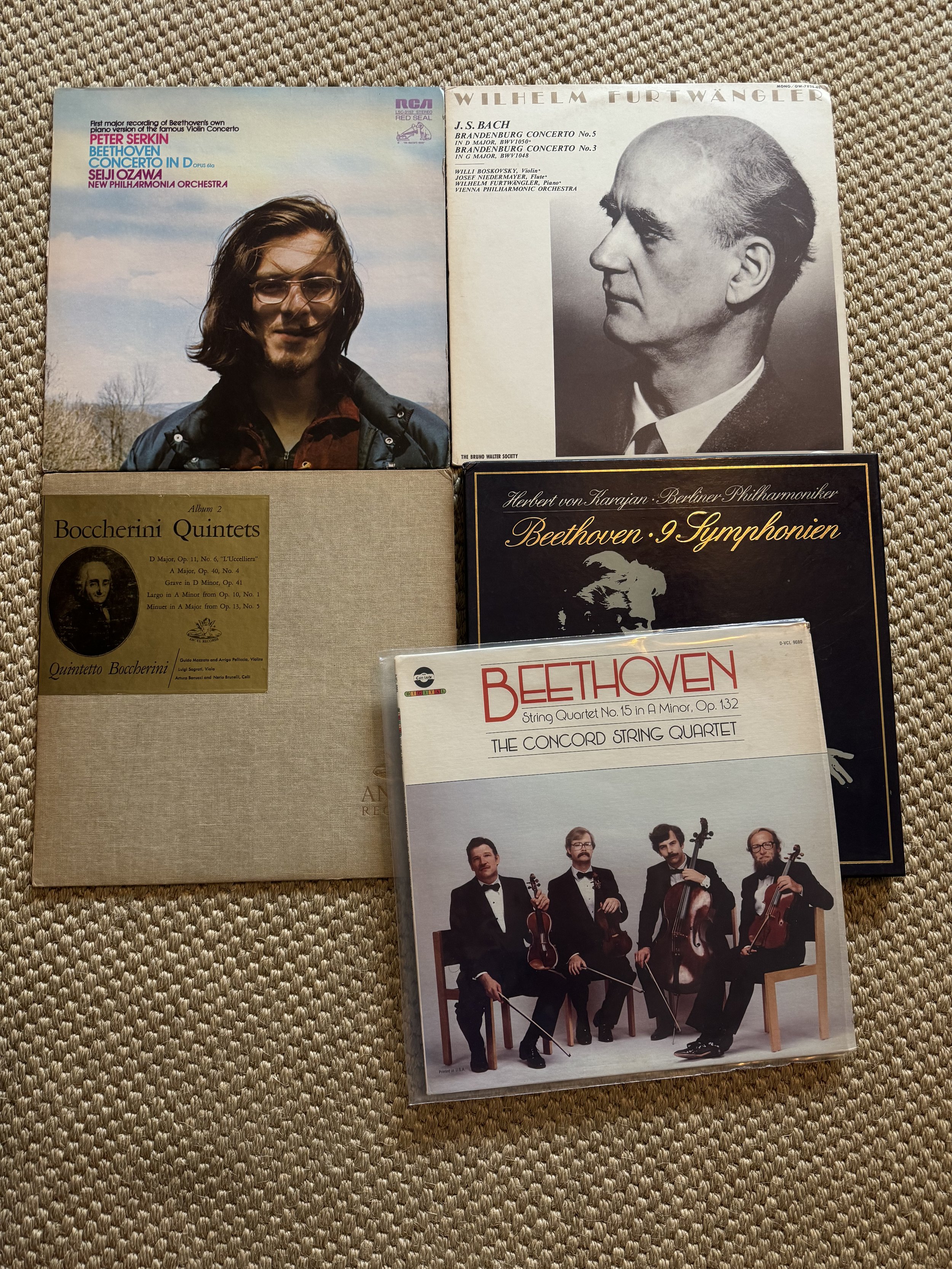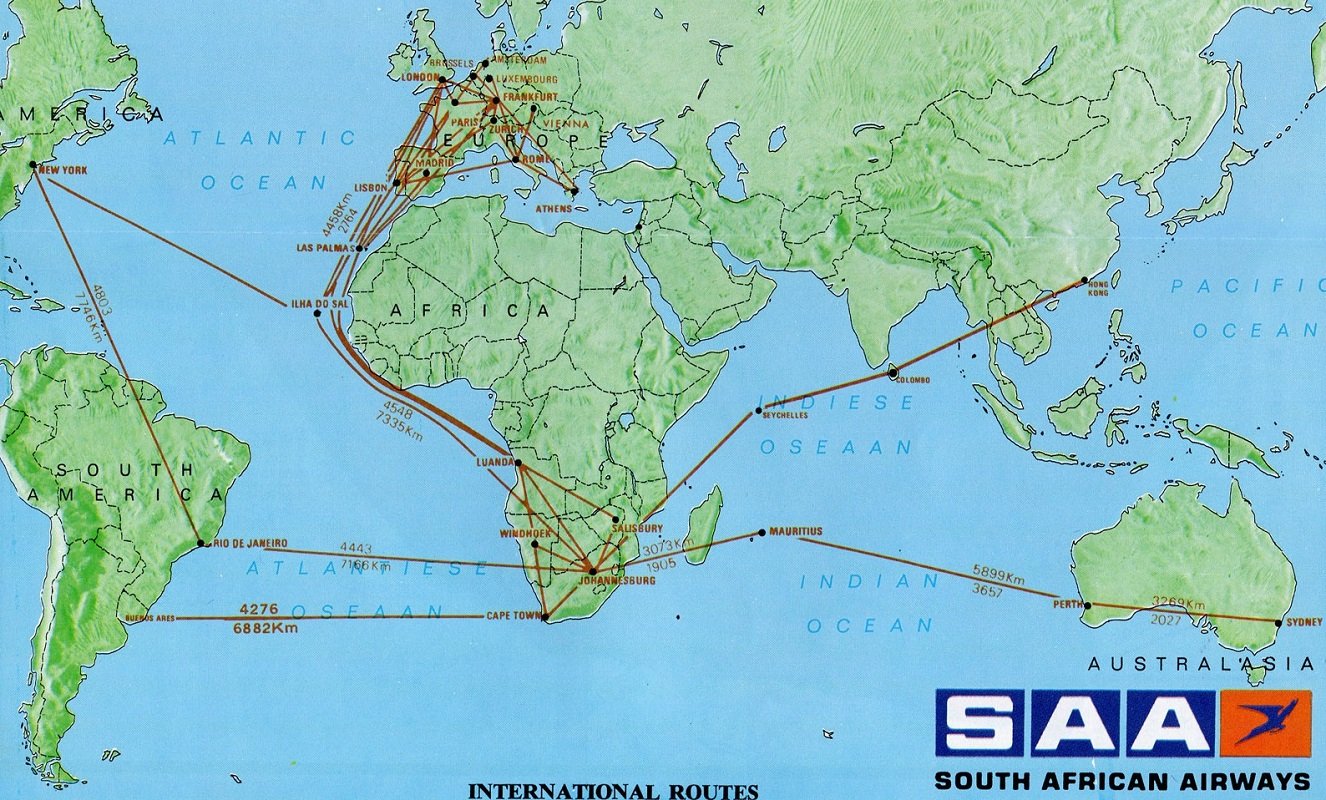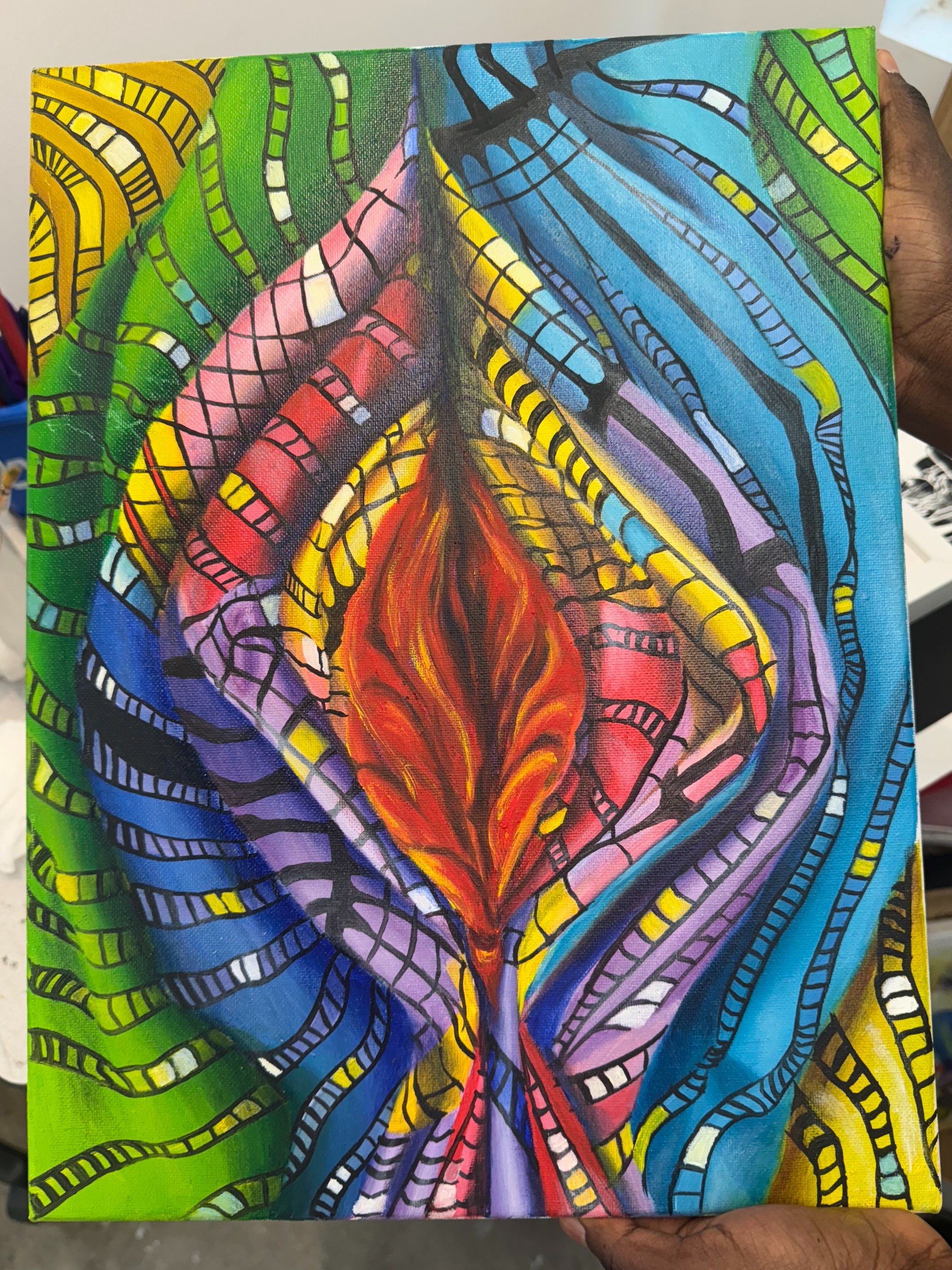Halcyon Days of a Boeing 747
Charles Meere, Australian Beach Pattern (1940), a painting that caught eye the eye of the founder of Charting Transcendence at the Art Gallery of New South Wales, Sydney in October 2016
Brief Updates & Highlights of What’s to Come
Bonnie Lautenberg, 2008, Slum Dog Millionaire - Cy Twombly, The Rose (2018), archival pigment print from her series ARTISTICA! that playfully and provocatively juxtaposes popular films with contemporary artworks created in the same year. Of particular interest to collectors these days are manifestations of ways that so-called “high” and “low” culture influence each other.
Charting Transcendence Inc. recently accepted an invitation to give three lectures in Palm Beach, Florida, as part of a privately curated lecture series in over the winter and spring of 2024-2025.
With luck the company will also end up co-curating an exhibition of contemporary art at a prestigious venue in the Miami Design District, opening in mid-October and running through Miami Art Week in early December.
Information about guided art tours and consultations at Art Basel Miami Beach 2024 will soon be available. Slots are expected to fill by mid-autumn, so please reach out soon in case you’re interested!
Some classical music recommendations from Charting Transcendence (YouTube links not necessarily to the precise recordings pictured) from upper left-hand corner clockwise:
1) Peter Serkin plays Beethoven’s opus 61a (his violin concerto transcribed for piano), conducted by Seiji Ozawa;
2) Wilhelm Furtwaengler’s magnificent piano recordings of Bach’s third and fifth Brandenburg concertos;
3) Karajan “gold standard” box set of all of 9 Beethoven’s symphonies conducted by the legendary Herbert von Karajan;
4) Concord String Quartet playing Beethoven’s late opus 132, including the slow, utterly sublime Sacred Song of Thanksgiving from a Convalescent to the Deity, in the Lydian Mode
5) Rare 1955 recording of Luigi Boccherini’s String Quintet G 276, the fascinating, birdsong-laced L’Ucceliera (The Aviary)
Finally Charting Transcendence also now offers consultations for music lovers and audiophiles who would like to gain a greater appreciation and connoisseurship for classical music. This service has evolved in response to repeated requests by clients and friends who have listened to me speak quite passionately on the subject over the years. Please reach out for more details!
Why Lately I’ve Been Thinking of Halcyon Days
halcyon days
definition: days characterized by happiness, great success, and prosperity, often used to describe an idyllic time in the past that is remembered as better than today
Every now and then, a new piece of contemporary art absolutely seizes my attention and causes me to feel very complex emotions that resonate to the core of my consciousness.
I’d like to share one such example from my rich and deep archive, something I saw at an art far in New York over six years ago.
Why was I so struck by this large drawing of a somewhat stubby-looking Boeing 747 with the inscription Halcyon Days?
Mikhael Subotzky (b. 1981, Cape Town), Sticky-tape Transfer 18 - Halcyon Days (or a Boeing 747, pride of the South African Airways) (2017), pigment inks, fineliner and J-Lar tape on cotton paper, shown by Goodman Gallery at Frieze New York, May 2018
As soon as I looked upon it, I recalled a story a former boss of mine — a so-called “old Africa hand” — had told me some 15 years earlier, when I was serving as a U.S. diplomat in Africa.
As it turns out, this is an image of a rather special airplane, for the South African apartheid government (1948-1993) maintained a fleet of planes just like it on behalf of their national airlines, Suid-Afrikaanse Lugdiens, or South African Airways (SAA)
Just as Emirates does for Dubai today, SAA played an integral role not only in connecting the country to the global economy but also in promoting a favorable PR reputation abroad.
Although Boeing manufactured only 45 examples of the 747-SP, this particular, truncated version was integral to SAL’s viability as an international flag carrier, since by the 1970s, nearly all sub-Saharan African countries had banned SAL from their airspace, precluding them from direct overflight of most of the continent.
And because it was shorter than a typical jumbo jet, the 747-SP sported a longer range, allowing it to fly from the tip of the African continent over the Indian or Atlantic Oceans on northbound routes.
International Route Map, South African Airways, April 1, 1974, accurately depicting the route their aircraft flew to Europe
Both technically and symbolically capable of obviating diplomatic pressure exerted on the government, this airplane was also a key tool that permitted apartheidists, who espoused theories of racial superiority and resisted integration while denying equal rights to its citizens, to maintain a sleek vernier of legitimacy in the eyes of developed nations.
However, one could also regard this this modified version of an American aviation icon as a symbolic middle finger raised to black-governed African nations. As years went by, the 747-SP continued to signal an increasingly lonely defiance towards sanctions imposed by the U.S. and other countries who loathed the racial injustice of apartheid and increasing came to regard South Africa as a pariah state.
After decades of increasing international economic and diplomatic pressure, South Africa finally permitted free elections in 1993, thus ending the apartheid regime.
South African Airways has long since rebranded and retired their fleet of 747-SPs, and new planes look quite different from the one above, sporting a livery of the new South African flag that reflects the patchwork nature of the country’s multicultural heritage.
And although I already knew this story when I first set my eyes on the artwork, the inscription Halycon Days made me feel very uncomfortable, even as I found myself strangely captivated by the image of the vintage airplane.
How on earth could this piece of art, created by a young, white South African photographer whose work had already been shown years before at MoMA, be conveying wistfulness for the “good old days” of apartheid?
Or did the artist, Mikhael Subotzky, intend the title to be sarcastic, tongue-in-cheek, ironic, or otherwise?
Although I do not know who ended up purchasing this artwork from South Africa’s esteemed Goodman Gallery, nor where it hangs today, I’ve been thinking a lot about it in recent days, as present political climate certainly makes one wistful for a simpler and more serene past.
This is just one example of the way my mind works, how I tend to map complex ideas and emotions in art and life — in fact it’s what I do every day. It’s why I’m proud to be Charting Transcendence.
Studio Visit with an Award-Winning Artist to Watch: Njeri Kinuthia
Njeri Kinuthia, Njeri the Great (2023), charcoal and pastel on paper, currently on display at the Orlando Museum of Art as part of the Florida Prize in Contemporary Art exhibition
A Florida-based collector in my network alerted me some months ago to a rising star in the contemporary art world, Njeri Kinuthia (b. 1998, Kenya), whose work I would highly encourage collectors keen on supporting emerging artists to be on the lookout for.
Notably, Njeri recently won a very prestigious contemporary art award, the Florida Prize in Contemporary Art for 2024, sponsored by the Orlando Museum of Art. Her work, including massive textile-based installations and other figurative pieces, remains on display there until late August.
Njeri graciously hosted me for a studio visit in Orlando several weeks ago, showing me an impressive body created during her recently completed MFA studies at the University of Central Florida.
While acquainting myself with her practice, I enjoyed hearing her impressions of coming to the United States from Kenya less than three years ago. In particular, the cultural freedom she has enjoyed here compared to how she was raised were striking.
Growing up in a conservative Christian Kikuyu family in Kenya, Njeri has claimed a powerful identity through her exploration of mixed media, incorporating mass-produced Kenyan textiles and conceptual aspects to challenge her home country’s cultural and gender norms. What results is an oeuvre that is feminist, bold, vulnerable, and often quite explicit, as she depicts herself in the nude, not shying away from examining her queer sexuality.
Looking at you, Looking at me (2022), woodcut print, part of Njeri’s graduate work at the University of Central Florida
V-folds (2023), oil on canvas, a stunning representation of essentialist feminist imagery incorporating references to the artist’s rich and innovative use of commercially-sourced Kenyan textiles
Sina Siri, Nina Jibu (2023), acrylic, beads and fabric on canvas. The title of this vulnerable, six-foot high self-portrait is a phrase in Kiswahili that means “I have no questions, only answers,” revealing the artist’s deft and subversive use of language in the spirit of prominent American feminist artists Jenny Holzer and Barbara Kruger.
Free (2022), charcoal and collage on paper, is a depiction of the artist, who grew up in a conservative Christian Kenyan household, wearing booty shorts for the very first time on her first trip to New York City just two years ago.
I tend to think Njeri’s practice — in particular the use of textiles and work that challenges the sexist nature of traditional African betrothal and marriage traditions — has just the right combination of elements that would favor her artwork being shown more widely with museums and galleries in the years to come.
Although Njeri is just one example (for I have others to share as well), I sincerely enjoy keeping an eye out for up-and-coming artists whose work is still available at very reasonable prices while already having gained solid recognition of excellence and the artist’s potential for creative growth.


